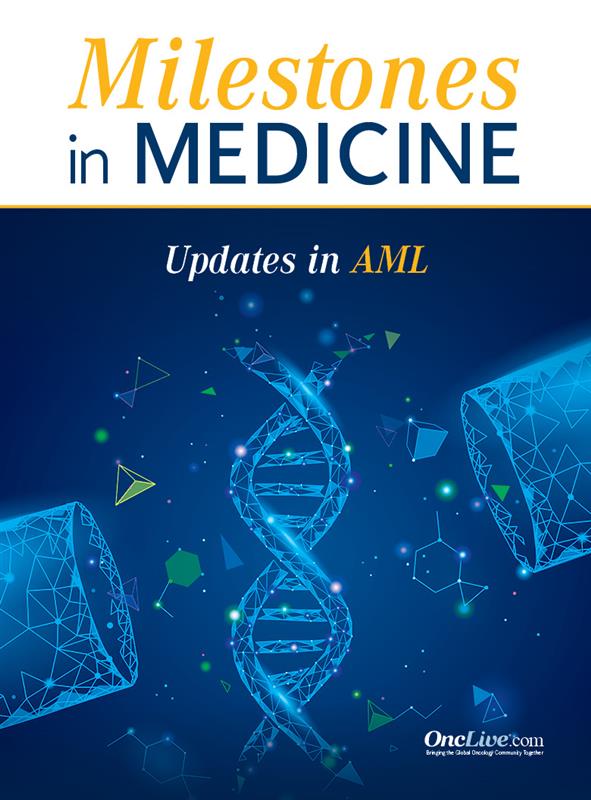Publication
Article
Targeting E-Selectin With Uproleselan Confers Potential Efficacy and Safety Benefits in AML
Author(s):
Uproleselan, an agent that disrupts the interaction between leukemia cells and their protective E-selectin microenvironment, is a promising novel AML therapy that may increase the efficacy and durability of other AML treatments.
Brian A. Jonas, MD, PhD

Uproleselan (GMI-1271), an agent that disrupts the interaction between leukemia cells and their protective E-selectin microenvironment, is a promising novel acute myeloid leukemia (AML) therapy that may increase the efficacy and durability of other AML treatments, including chemotherapy and venetoclax (Venclexta), according to Brian Jonas, MD, PhD.
A phase 1/2 trial (NCT02306291) evaluated the viability of targeting E-selectin to overcome extrinsic mechanisms of chemoresistance by investigating uproleselan plus MEC (mitoxantrone, etoposide, and cytarabine) chemotherapy in AML. Among patients with relapsed/refractory disease, uproleselan elicited a 41% remission rate and a median overall survival of 8.8 months.1 Additionally, in the relapsed/refractory cohort, 11 out of 16 patients evaluable for minimal residual disease (MRD) who received uproleselan achieved MRD negativity and were able to proceed to transplant.
“Uproleselan seemed to enhance the efficacy of the chemotherapy, it seemed to have a favorable safety profile in combination with chemotherapy, and it potentially made some of the chemotherapy toxicities less [severe] than what you’d expect,” Jonas said.
In an interview with OncLive®, Jonas discussed the rationale behind the novel approach of targeting the AML tumor microenvironment, encouraging results with uproleselan from the phase 1/2 trial, and the potential versatility of uproleselan use with a broad variety of standard-of-care (SOC) AML treatments. Jonas is an associate professor of medicine at UC Davis Health in Sacramento, California.
OncLive®: What key updates in the AML treatment landscape would you like to highlight?
Jonas: There have been a number, certainly within the past year or so, including some new FDA approvals. For example, the [phase 3] QUAZAR AML-001 study [NCT01757535] led to the FDA approval of oral azacitidine [Onureg] maintenance for patients who had been treated with induction [and/or consolidation] chemotherapy. That was a bit of a paradigm change since we hadn’t done much maintenance therapy in AML.
Another big study that came out [in April 2022] in the New England Journal of Medicine was the [phase 3] AGILE trial [NCT03173248], which established a new SOC for older patients who are ineligible for induction with the combination of ivosidenib [Tibsovo] and azacitidine. Now there are multiple potential treatment options for those patients.
At the [2022 EHA Congress], the [phase 3] QuANTUM-First study [NCT02668653] was presented, and it was positive [when compared with a placebo arm], showing improved survival in patients with FLT3-ITD–mutated AML who received the combination of 7+3 with quizartinib, another FLT3 inhibitor, and consolidation post-transplant or as continuation therapy. Quizartinib is not approved yet, but that’s an impactful study. Those are 3 big updates in the field.
What is the role of E-selectin within the tumor microenvironment, and what is the rationale of investigating it in patients with AML?
E-selectin is involved in the expression of endothelial cells in the microvasculature of the bone marrow, and it’s involved in the maintenance of normal hematopoietic stem cells. However, the leukemia cells can co-opt the system. They can express the E-selectin ligand, which then gives them protection from chemotherapy and from the various bone marrow microenvironment–mediated protected pathways. It’s a way for them to enhance their own safety in a receptive microenvironment.
That begs the question: Could this be a targetable situation? We don’t have much experience targeting the microenvironment in AML yet. What’s interesting about the development of uproleselan [is that it’s] a drug that targets the AML cells’ interaction with their microenvironment. The rationale is that if you inhibit this interaction between E-selectin and the E-selectin ligand on the leukemia cells, they lose that receptive microenvironment protection from chemotherapy and the receptive area that supports their growth.
How does E-selectin affect treatment resistance patterns in AML?
Preclinical models with uproleselan, the E-selectin antagonist, led to an enhancement of chemotherapy efficacy. Interestingly, uproleselan also led to decreased rates of mucositis. It was also thought to protect the normal hematopoietic stem cells from the effects of chemotherapy. It has this potential dual purpose of both increasing the efficacy of the treatment and protecting from some of the adverse effects of the treatment.
With that in mind, the microenvironment plays a role in AML, whether it’s in de novo disease, in relapsed or refractory disease, or in a younger or older person. In theory, this interaction could be important for all phases of AML therapy and all types of AML diseases, ranging from younger to older patients, [those with] different biologies, and so on. It potentially has far-ranging implications.
What is uproleselan’s unique mechanism of action in AML?
Uproleselan is a rationally designed glycomimetic, a glycosylated molecule. It disrupts the interaction between E-selectin and the E-selectin ligand. This disruption leads to the release of the leukemia cells, or the E-selectin–expressing cells, from their contact with E-selectin. Therefore, they lose their protective environment.
What efficacy data did you and your colleagues report from the phase 1/2 study of uproleselan plus chemotherapy in relapsed/refractory AML?
This study was reported in Blood [in February 2022], and [Daniel J. DeAngelo, MD, PhD, of Dana-Farber Cancer Institute in Boston, Massachusetts] was the first author. This study had 2 arms. Initially, there was a lead-in with patients with relapsed/refractory disease in combination with MEC chemotherapy. Subsequently, the expansion phase had 2 arms; 1 was an up-front approach in older patients in combination with 7+3, and the other was a continuation of the MEC arm in relapsed/refractory patients.
In the patients with relapsed/refractory disease the remission rate was promising, at 41%. The population that ended up being enrolled on the study included many refractory patients, who tend to do worse, and also patients with shorter durations of first remission. Although they were technically relapsed, that population tends to have a biology and/or prognosis more consistent with refractory disease.
Some patients achieved an MRD-negative response, and that level of remission is becoming increasingly sought after in AML therapy. Patients were able to bridge to transplantation, which, in the relapsed/refractory setting, is your main goal overall.
In the up-front patients, the response rate was 72%, which is a good response rate for an older population. Although we need to be careful with cross-trial and historical comparisons, it’s reasonable to say that [the findings from both these arms] compared favorably with what we’ve seen in the past.
The addition of uproleselan to the MEC chemotherapy or the 7+3 did not seem to cause much additional toxicity. I would characterize the toxicity as being mostly consistent with what you would expect from intensive chemotherapy. [Interestingly, however,] although MEC is notorious for causing mucositis, this effect was rarely seen in that arm. Preclinical data suggest that uproleselan might protect against mucositis.
Additionally, there’s a potential role for the E-selectin ligand as a biomarker. When we start thinking about the future, [we ask]: Could there be a role for determining the E-selectin expression on a disease as a predictive marker to use this treatment? The patients who had higher E-selectin expression in the phase 1/2 trial did better than those with lower expression. That also merits additional confirmatory studies.
What are the next steps for investigating uproleselan in combination with chemotherapy and potentially in combination with agents such as venetoclax that are already in the AML armamentarium?
Uproleselan has a potential role with any treatment of AML. It has a potential role with any stage of disease and any disease population. Indeed, preclinical data support its use in combination with other regimens like azacitidine. The uses of uproleselan could certainly expand, so a combination with venetoclax is a reasonable idea.
[UC Davis is running] an investigator-initiated trial with venetoclax in combination with azacitidine and uproleselan in patients who are unfit for intensive chemotherapy. It’d be interesting to see if this can enhance outcomes relative to what you’d expect with azacitidine and venetoclax alone.
The FLAG-IDA [fludarabine, cytarabine, idarubicin, and granulocyte colony stimulating factor] plus venetoclax data coming out of [The University of Texas MD Anderson Cancer Center in Houston] also looks promising. Could uproleselan be added to that regimen, and maybe even improve its toxicity profile, [based on what] the agent has shown so far? We could pursue many interesting avenues with uproleselan down the line, in combination with both high-intensity and low-intensity regimens.
What other ongoing AML research are you particularly intrigued by?
[Regarding] FLT3 inhibitors and oral azacitidine, there are many interesting investigations out there and pathways forward where we could go. The incorporation of oral hypomethylating agents into treatment with venetoclax is something that I’m eager to see. If they work out, they could potentially be great for patient quality of life and resource utilization.
I’m curious to see some of the studies that are looking at venetoclax and azacitidine in younger patients in a randomized fashion with intensive chemotherapy, for example. Maybe this is a paradigm shift that we’re moving toward, as many of us believe that maybe 7+3, which has been around since the early 1970s, has seen its day.
The FLAG-IDA plus venetoclax data coming out of MD Anderson is also intriguing, and it’ll be interesting to see how those fare in a randomized fashion or at other centers. That’s another area of excitement, and the list could go on.
[Regarding] other targeted drugs, I’m excited to see where the menin inhibitors go. The mechanism of targeting NPM1 mutations, at least indirectly, works in mixed lineage leukemia–rearranged AMLs. This is an exciting new advance.
Additionally, CD47 antibodies like magrolimab have shown some exciting preliminary data in AML and myelodysplastic syndrome. There’s an interest in targeting TP53 with those drugs. Similarly, it will be interesting to see where the TP53-targeting [agent] eprenetapopt goes after the results of the most recent study.
This is exciting because I always tell people that AML was the first cancer genome to be fully sequenced, and we’ve been reaping the rewards of all this sequencing and biological insight that we determined in the past decade and a half. Now, it’s coming to fruition with all these new targeted drugs that are incrementally pushing the field forward [and contributing to] major advances in the past few years since the first approval of midostaurin opened the floodgates to all these new drugs.
What main message would you like to leave with colleagues regarding the investigation of E-selectin and uproleselan?
Randomized studies are looking at uproleselan vs placebo. Those trials are necessary to [know] whether this is a drug that should be added to our standard treatments. However, based on the phase 1/2 trial, it certainly looks promising, pending those confirmatory studies.
Reference
DeAngelo DJ, Jonas BA, Liesveld JL, et al. Phase 1/2 study of uproleselan added to chemotherapy in patients with relapsed or refractory acute myeloid leukemia. Blood. 2022;139(8):1135-1146.doi:10.1182/blood.2021010721






